Cetacea
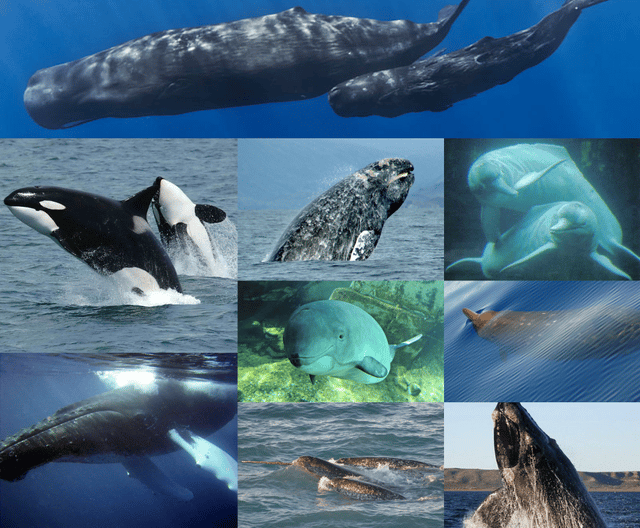
Cetacea

| Cetaceans | |
|---|---|
| Clockwise from top: sperm whale (Physeter macrocephalus), Amazon river dolphin (Inia geoffrensis), Blainville's beaked whale (Mesoplodon densirostris), southern right whale (Eubalaena australis), narwhal (Monodon monoceros), humpback whale (Megaptera novaeangliae), killer whale (Orcinus orca), gray whale (Eschrichtius robustus) and harbor porpoise (Phocoena phocoena). | |
| Scientific classification | |
| Kingdom: | Animalia |
| Phylum: | Chordata |
| Class: | Mammalia |
| Order: | Artiodactyla |
| Suborder: | Whippomorpha |
| Infraorder: | Cetacea Brisson, 1762 |
| Parvorders | |
| Mysticeti Odontoceti †Archaeoceti (see text for families) | |
| Diversity | |
| Around 88 species | |
Cetaceans (/sɪˈteɪʃəns/) (from Latin: cetus, lit. 'whale', from Ancient Greek: κῆτος, romanized: kētos, lit. 'huge fish')[1] are aquatic mammals constituting the infraorder Cetacea. There are around 89 living species, which are divided into two parvorders. The first is the Odontoceti, the toothed whales, which consist of around 70 species, including the dolphin (which includes killer whales), porpoise, beluga whale, narwhal, sperm whale, and beaked whale. The second is the Mysticeti, the baleen (from Latin: balæna, lit. 'whale') whales, which have a filter-feeder system, and consist of 15 species divided into 3 families, and include the right whale, bowhead whale, rorqual, pygmy right whale, and gray whale.
The ancient and extinct ancestors of modern whales (Archaeoceti) lived 53 to 45 million years ago. They diverged from even-toed ungulates; their closest living relatives are hippopotamuses and others such as cows and pigs. They were semiaquatic and evolved in the shallow waters that separated India from Asia. Around 30 species adapted to a fully oceanic life. Baleen whales split from toothed whales around 34 million years ago.
The smallest cetacean is Maui's dolphin, at 1 m (3 ft 3 in) and 50 kg (110 lb); the largest is the blue whale,[2] at 29.9 m (98 ft) and 173 t (381,000 lb). Baleen whales have a tactile system in the short hairs (vibrissae) around their mouth; toothed whales do not have vibrissae. Cetaceans have well-developed senses—their eyesight and hearing are adapted for both air and water. They have a layer of fat, or blubber, under the skin to maintain body heat in cold water. Several species exhibit sexual dimorphism. Two external forelimbs are modified into flippers; two internal hindlimbs are vestigial. Cetaceans have streamlined bodies: they can swim very quickly, with the killer whale able to travel at 56 kilometres per hour (35 mph) in short bursts, the fin whale able to cruise at 48 kilometres per hour (30 mph), dolphins able to make very tight turns at high speeds,[3] and some species diving to great depths.
Although cetaceans are widespread, most species prefer the colder waters of the Northern and Southern Hemispheres. They spend their lives in the water of seas and rivers; having to mate, give birth, molt or escape from predators, like killer whales, underwater. This has drastically affected their anatomy to be able to do so. They feed largely on fish and marine invertebrates; but a few, like the killer whale, feed on large mammals and birds, such as penguins and seals. Some baleen whales (mainly gray whales and right whales) are specialised for feeding on benthic creatures. Male cetaceans typically mate with more than one female (polygyny), although the degree of polygyny varies with the species. Cetaceans are not known to have pair bonds. Male cetacean strategies for reproductive success vary between herding females, defending potential mates from other males, or whale song which attracts mates. Calves are typically born in the fall and winter months, and females bear almost all the responsibility for raising them. Mothers of some species fast and nurse their young for a relatively short period of time, which is more typical of baleen whales as their main food source (invertebrates) aren't found in their breeding and calving grounds (tropics). Cetaceans produce a number of vocalizations, notably the clicks and whistles of dolphins and the moaning songs of the humpback whale.
The meat, blubber and oil of cetaceans have traditionally been used by indigenous peoples of the Arctic. Cetaceans have been depicted in various cultures worldwide. Dolphins are commonly kept in captivity and are even sometimes trained to perform tricks and tasks, other cetaceans aren't as often kept in captivity (with usually unsuccessful attempts). Cetaceans have been extensively hunted by commercial industries for their products, although hunting the largest whales is now forbidden by international law. The baiji (Chinese river dolphin) has become "Possibly Extinct" in the past century, while the vaquita and Yangtze finless porpoise are ranked Critically Endangered by the International Union for Conservation of Nature. Besides hunting, cetaceans also face threats from accidental trapping and environmental hazards such as marine pollution, noise pollution and ongoing climate change.
| Cetaceans | |
|---|---|
| Clockwise from top: sperm whale (Physeter macrocephalus), Amazon river dolphin (Inia geoffrensis), Blainville's beaked whale (Mesoplodon densirostris), southern right whale (Eubalaena australis), narwhal (Monodon monoceros), humpback whale (Megaptera novaeangliae), killer whale (Orcinus orca), gray whale (Eschrichtius robustus) and harbor porpoise (Phocoena phocoena). | |
| Scientific classification | |
| Kingdom: | Animalia |
| Phylum: | Chordata |
| Class: | Mammalia |
| Order: | Artiodactyla |
| Suborder: | Whippomorpha |
| Infraorder: | Cetacea Brisson, 1762 |
| Parvorders | |
| Mysticeti Odontoceti †Archaeoceti (see text for families) | |
| Diversity | |
| Around 88 species | |
Baleen whales and toothed whales
The two parvorders, baleen whales (Mysticeti) and toothed whales (Odontoceti), are thought to have diverged around thirty-four million years ago.
Baleen whales have bristles made of keratin instead of teeth. The bristles filter krill and other small invertebrates from seawater. Grey whales feed on bottom-dwelling mollusks. Rorqual family (balaenopterids) use throat pleats to expand their mouths to take in food and sieve out the water. Balaenids (right whales and bowhead whales) have massive heads that can make up 40% of their body mass. Most mysticetes prefer the food-rich colder waters of the Northern and Southern Hemispheres, migrating to the Equator to give birth. During this process, they are capable of fasting for several months, relying on their fat reserves.
The parvorder of Odontocetes – the toothed whales – include sperm whales, beaked whales, killer whales, dolphins and porpoises. Generally the teeth are designed for catching fish, squid or other marine invertebrates, not for chewing them, so prey is swallowed whole. Teeth are shaped like cones (dolphins and sperm whales), spades (porpoises), pegs (belugas), tusks (narwhals) or variable (beaked whale males). Female beaked whales' teeth are hidden in the gums and are not visible, and most male beaked whales have only two short tusks. Narwhals have vestigial teeth other than their tusk, which is present on males and 15% of females and has millions of nerves to sense water temperature, pressure and salinity. A few toothed whales, such as some killer whales, feed on mammals, such as pinnipeds and other whales.
Toothed whales have well-developed senses – their eyesight and hearing are adapted for both air and water, and they have advanced sonar capabilities using their melon. Their hearing is so well-adapted for both air and water that some blind specimens can survive. Some species, such as sperm whales, are well adapted for diving to great depths. Several species of toothed whales show sexual dimorphism, in which the males differ from the females, usually for purposes of sexual display or aggression.
Anatomy

Dolphin anatomy
Cetacean bodies are generally similar to that of fish, which can be attributed to their lifestyle and the habitat conditions. Their body is well-adapted to their habitat, although they share essential characteristics with other higher mammals (Eutheria).[4]
They have a streamlined shape, and their forelimbs are flippers. Almost all have a dorsal fin on their backs that can take on many forms depending on the species. A few species, such as the beluga whale, lack them. Both the flipper and the fin are for stabilization and steering in the water.
The body is wrapped in a thick layer of fat, known as blubber, used for thermal insulation and gives cetaceans their smooth, streamlined body shape. In larger species, it can reach a thickness up to half a meter (1.6 ft).
Sexual dimorphism evolved in many toothed whales. Sperm whales, narwhals, many members of the beaked whale family, several species of the porpoise family, killer whales, pilot whales, eastern spinner dolphins and northern right whale dolphins show this characteristic.[7] Males in these species developed external features absent in females that are advantageous in combat or display. For example, male sperm whales are up to 63% percent larger than females, and many beaked whales possess tusks used in competition among males.[7][8] Hind legs are not present in cetaceans, nor are any other external body attachments such as a pinna and hair.[9]
Head
Whales have an elongated head, especially baleen whales, due to the wide overhanging jaw. Bowhead whale plates can be 9 metres (30 ft) long. Their nostril(s) make up the blowhole, with one in toothed whales and two in baleen whales.
The nostrils are located on top of the head above the eyes so that the rest of the body can remain submerged while surfacing for air. The back of the skull is significantly shortened and deformed. By shifting the nostrils to the top of the head, the nasal passages extend perpendicularly through the skull.[10] The teeth or baleen in the upper jaw sit exclusively on the maxilla. The braincase is concentrated through the nasal passage to the front and is correspondingly higher, with individual cranial bones that overlap.
In toothed whales, connective tissue exists in the melon as a head buckle. This is filled with air sacs and fat that aid in buoyancy and biosonar. The sperm whale has a particularly pronounced melon; this is called the spermaceti organ and contains the eponymous spermaceti, hence the name "sperm whale". Even the long tusk of the narwhal is a vice-formed tooth. In many toothed whales, the depression in their skull is due to the formation of a large melon and multiple, asymmetric air bags.
River dolphins, unlike most other cetaceans, can turn their head 90°. Other cetaceans have fused neck vertebrae and are unable to turn their head at all.
The baleen of baleen whales consists of long, fibrous strands of keratin. Located in place of the teeth, it has the appearance of a huge fringe and is used to sieve the water for plankton and krill.
Brain
The neocortex of many cetaceans is home to elongated spindle neurons that, prior to 2019, were known only in hominids.[11] In humans, these cells are thought to be involved in social conduct, emotions, judgment and theory of mind.[12] Cetacean spindle neurons are found in areas of the brain homologous to where they are found in humans, suggesting they perform a similar function.[13]
Brain size was previously considered a major indicator of intelligence. Since most of the brain is used for maintaining bodily functions, greater ratios of brain to body mass may increase the amount of brain mass available for cognitive tasks. Allometric analysis indicates that mammalian brain size scales at approximately two-thirds or three-quarter exponent of the body mass.[14] Comparison of a particular animal's brain size with the expected brain size based on such an analysis provides an encephalization quotient that can be used as an indication of animal intelligence. Sperm whales have the largest brain mass of any animal on earth, averaging 8,000 cm3 (490 in3) and 7.8 kg (17 lb) in mature males.[15] The brain to body mass ratio in some odontocetes, such as belugas and narwhals, is second only to humans.[16] In some whales, however, it is less than half that of humans: 0.9% versus 2.1%. The sperm whale (Physeter macrocephalus) is the largest of all toothed predatory animals and possesses the largest brain.
Skeleton
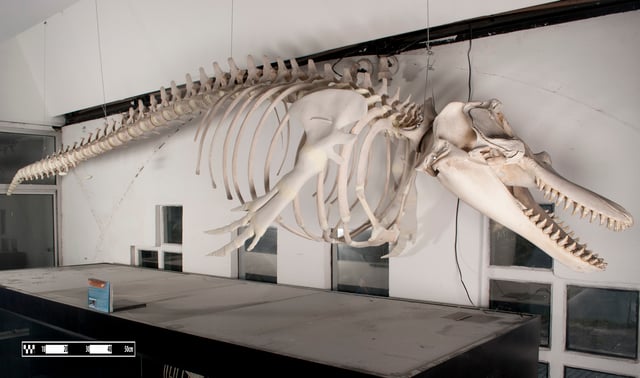
Killer whale skeleton

Sperm whale skeleton

Bowhead whale skeleton
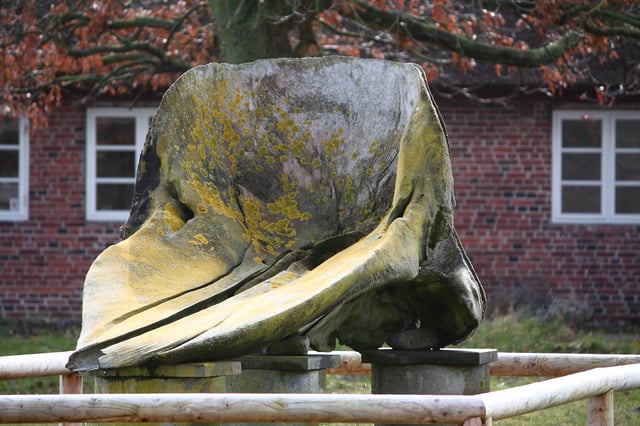
Weathered upper jaw of a sperm whale.

Skeleton of a blue whale standing outside the Long Marine Laboratory of the University of California, Santa Cruz.
The cetacean skeleton is largely made up of cortical bone, which stabilizes the animal in the water. For this reason, the usual terrestrial compact bones, which are finely woven cancellous bone, are replaced with lighter and more elastic material. In many places, bone elements are replaced by cartilage and even fat, thereby improving their hydrostatic qualities. The ear and the muzzle contain a bone shape that is exclusive to cetaceans with a high density, resembling porcelain. This conducts sound better than other bones, thus aiding biosonar.
The number of vertebrae that make up the spine varies by species, ranging from forty to ninety-three. The cervical spine, found in all mammals, consists of seven vertebrae which, however, are reduced or fused. This fusion provides stability during swimming at the expense of mobility. The fins are carried by the thoracic vertebrae, ranging from nine to seventeen individual vertebrae. The sternum is cartilaginous. The last two to three pairs of ribs are not connected and hang freely in the body wall. The stable lumbar and tail include the other vertebrae. Below the caudal vertebrae is the chevron bone.
The front limbs are paddle-shaped with shortened arms and elongated finger bones, to support movement. They are connected by cartilage. The second and third fingers display a proliferation of the finger members, a so-called hyperphalangy. The shoulder joint is the only functional joint in all cetaceans except for the Amazon river dolphin. The collarbone is completely absent.
Fluke
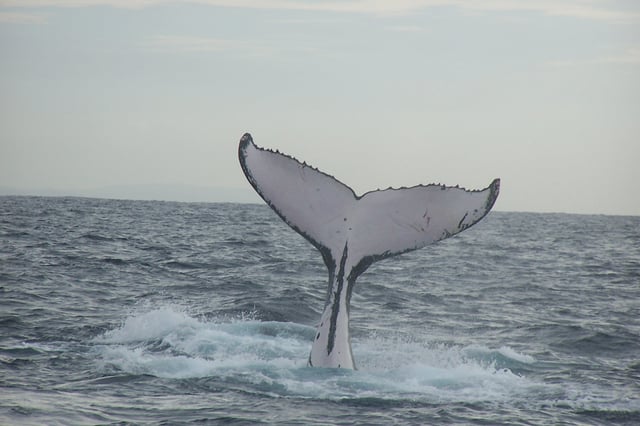
Humpback whale fluke
They have a cartilaginous fluke at the end of their tails that is used for propulsion. The fluke is set horizontally on the body, unlike fish, which have vertical tails.
Physiology
Circulation
Cetaceans have powerful hearts. Blood oxygen is distributed effectively throughout the body. They are warm-blooded, i.e., they hold a nearly constant body temperature.
Respiration
Cetaceans have lungs, meaning they breathe air. An individual can last without a breath from a few minutes to over two hours depending on the species. Cetacea are deliberate breathers who must be awake to inhale and exhale. When stale air, warmed from the lungs, is exhaled, it condenses as it meets colder external air. As with a terrestrial mammal breathing out on a cold day, a small cloud of 'steam' appears. This is called the 'spout' and varies across species in shape, angle and height. Species can be identified at a distance using this characteristic.
The structure of the respiratory and circulatory systems is of particular importance for the life of marine mammals. The oxygen balance is effective. Each breath can replace up to 90% of the total lung volume. For land mammals, in comparison, this value is usually about 15%. During inhalation, about twice as much oxygen is absorbed by the lung tissue as in a land mammal. As with all mammals, the oxygen is stored in the blood and the lungs, but in cetaceans, it is also stored in various tissues, mainly in the muscles. The muscle pigment, myoglobin, provides an effective bond. This additional oxygen storage is vital for deep diving, since beyond a depth around 100 m (330 ft), the lung tissue is almost completely compressed by the water pressure.
Organs
The stomach consists of three chambers. The first region is formed by a loose gland and a muscular forestomach (missing in beaked whales), which is then followed by the main stomach and the pylorus. Both are equipped with glands to help digestion. A bowel adjoins the stomachs, whose individual sections can only be distinguished histologically. The liver is large and separate from the gall bladder.[17]
The kidneys are long and flattened. The salt concentration in cetacean blood is lower than that in seawater, requiring kidneys to excrete salt. This allows the animals to drink seawater.[18]
Senses
Cetacean eyes are set on the sides rather than the front of the head. This means only species with pointed 'beaks' (such as dolphins) have good binocular vision forward and downward. Tear glands secrete greasy tears, which protect the eyes from the salt in the water. The lens is almost spherical, which is most efficient at focusing the minimal light that reaches deep water. Cetaceans are known to possess excellent hearing.[19]
At least one species, the tucuxi or Guiana dolphin, is able to use electroreception to sense prey.[20]
Ears
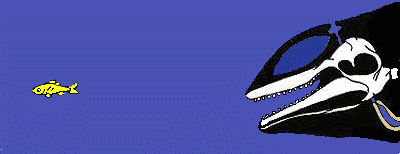
Biosonar
The external ear has lost the pinna (visible ear), but still retains a narrow external auditory meatus. To register sounds, instead, the posterior part of the mandible has a thin lateral wall (the pan bone) fronting a concavity that houses a fat pad. The pad passes anteriorly into the greatly enlarged mandibular foramen to reach in under the teeth and posteriorly to reach the thin lateral wall of the ectotympanic. The ectotympanic offers a reduced attachment area for the tympanic membrane. The connection between this auditory complex and the rest of the skull is reduced—to a single, small cartilage in oceanic dolphins.
In odontocetes, the complex is surrounded by spongy tissue filled with air spaces, while in mysticetes, it is integrated into the skull as with land mammals. In odontocetes, the tympanic membrane (or ligament) has the shape of a folded-in umbrella that stretches from the ectotympanic ring and narrows off to the malleus (quite unlike the flat, circular membrane found in land mammals.) In mysticetes, it also forms a large protrusion (known as the "glove finger"), which stretches into the external meatus and the stapes are larger than in odontocetes. In some small sperm whales, the malleus is fused with the ectotympanic.
The ear ossicles are pachyosteosclerotic (dense and compact) and differently shaped from land mammals (other aquatic mammals, such as sirenians and earless seals, have also lost their pinnae). T semicircular canals are much smaller relative to body size than in other mammals.[21]
The auditory bulla is separated from the skull and composed of two compact and dense bones (the periotic and tympanic) referred to as the tympanoperiotic complex. This complex is located in a cavity in the middle ear, which, in the Mysticeti, is divided by a bony projection and compressed between the exoccipital and squamosal, but in the odontoceti, is large and completely surrounds the bulla (hence called "peribullar"), which is, therefore, not connected to the skull except in physeterids. In the Odontoceti, the cavity is filled with a dense foam in which the bulla hangs suspended in five or more sets of ligaments. The pterygoid and peribullar sinuses that form the cavity tend to be more developed in shallow water and riverine species than in pelagic Mysticeti. In Odontoceti, the composite auditory structure is thought to serve as an acoustic isolator, analogous to the lamellar construction found in the temporal bone in bats.[22]
Cetaceans use sound to communicate, using groans, moans, whistles, clicks or the 'singing' of the humpback whale.[20]
Echolocation
Odontoceti are generally capable of echolocation.[23] They can discern the size, shape, surface characteristics, distance and movement of an object. They can search for, chase and catch fast-swimming prey in total darkness. Most Odontoceti can distinguish between prey and nonprey (such as humans or boats); captive Odontoceti can be trained to distinguish between, for example, balls of different sizes or shapes. Echolocation clicks also contain characteristic details unique to each animal, which may suggest that toothed whales can discern between their own click and that of others.[24]
Mysticeti have exceptionally thin, wide basilar membranes in their cochleae without stiffening agents, making their ears adapted for processing low to infrasonic frequencies.[25]
Chromosomes
The initial karyotype includes a set of chromosomes from 2n = 44. They have four pairs of telocentric chromosomes (whose centromeres sit at one of the telomeres), two to four pairs of subtelocentric and one or two large pairs of submetacentric chromosomes. The remaining chromosomes are metacentric—the centromere is approximately in the middle—and are rather small. Sperm whales, beaked whales and right whales converge to a reduction in the number of chromosomes to 2n = 42.[26]
Ecology
Range and habitat
Cetaceans are found in all places. River dolphin species live exclusively in fresh water. While many marine species, such as the blue whale, the humpback whale and the killer whale, have a distribution area that includes nearly the entire ocean, some species occur only locally or in broken populations. These include the vaquita, which inhabits a small part of the Gulf of California and Hector's dolphin, which lives in some coastal waters in New Zealand. Both species prefer deeper marine areas and species that live frequently or exclusively in coastal and shallow water areas.
Many species inhabit specific latitudes, often in tropical or subtropical waters, such as Bryde's whale or Risso's dolphin. Others are found only in a specific body of water. The southern right whale dolphin and the hourglass dolphin live only in the Southern Ocean. The narwhal and the beluga live only in the Arctic Ocean. Sowerby's beaked whale and the Clymene dolphin exist only in the Atlantic and the Pacific white-sided dolphin and the northern straight dolphin live only in the North Pacific.
Cosmopolitan species may be found in the Pacific, Atlantic and Indian Oceans. However, northern and southern populations become genetically separated over time. In some species, this separation leads eventually to a divergence of the species, such as produced the southern right whale, North Pacific right whale and North Atlantic right whale.[27] Migratory species' reproductive sites often lie in the tropics and their feeding grounds in polar regions.
Thirty-two species are found in European waters, including twenty-five toothed and seven baleen species.
Whale migration
Many species of whales migrate on a latitudinal basis to move between seasonal habitats. For example, the gray whale migrates 10,000 miles round trip. The journey begins at winter birthing grounds in warm lagoons along Baja California, and traverses 5,000-7,000 miles of coastline to summer feeding grounds in the Bering, Chuckchi and Beaufort seas off the coast of Alaska.[28]
Behaviour
Sleep
Conscious breathing cetaceans sleep but cannot afford to be unconscious for long, because they may drown. While knowledge of sleep in wild cetaceans is limited, toothed cetaceans in captivity have been recorded to exhibit unihemispheric slow-wave sleep (USWS), which means they sleep with one side of their brain at a time, so that they may swim, breathe consciously and avoid both predators and social contact during their period of rest.[29]
A 2008 study found that sperm whales sleep in vertical postures just under the surface in passive shallow 'drift-dives', generally during the day, during which whales do not respond to passing vessels unless they are in contact, leading to the suggestion that whales possibly sleep during such dives.[30]
Diving
While diving, the animals reduce their oxygen consumption by lowering the heart activity and blood circulation; individual organs receive no oxygen during this time. Some rorquals can dive for up to 40 minutes, sperm whales between 60 and 90 minutes and bottlenose whales for two hours. Diving depths average about 100 m (330 ft). Species such as sperm whales can dive to 3,000 m (9,800 ft), although more commonly 1,200 metres (3,900 ft).[31][32]
Social relations
Most whales are social animals, although a few species live in pairs or are solitary. A group, known as a pod, usually consists of ten to fifty animals, but on occasion, such as mass availability of food or during mating season, groups may encompass more than one thousand individuals. Inter-species socialization can occur.[33]
Pods have a fixed hierarchy, with the priority positions determined by biting, pushing or ramming. The behavior in the group is aggressive only in situations of stress such as lack of food, but usually it is peaceful. Contact swimming, mutual fondling and nudging are common. The playful behavior of the animals, which is manifested in air jumps, somersaults, surfing, or fin hitting, occurs more often than not in smaller cetaceans, such as dolphins and porpoises.[33]
Whale song
Males in some baleen species communicate via whale song, sequences of high pitched sounds. These "songs" can be heard for hundreds of kilometers. Each population generally shares a distinct song, which evolves over time. Sometimes, an individual can be identified by its distinctive vocals, such as the 52-hertz whale that sings at a higher frequency than other whales. Some individuals are capable of generating over 600 distinct sounds.[33] In baleen species such as humpbacks, blues and fins, male-specific song is believed to be used to attract and display fitness to females.[34]
Hunting
Pod groups also hunt, often with other species. Many species of dolphins accompany large tunas on hunting expeditions, following large schools of fish. The killer whale hunts in pods and targets belugas and even larger whales. Humpback whales, among others, form in collaboration bubble carpets to herd krill or plankton into bait balls before lunging at them.[33]
Intelligence
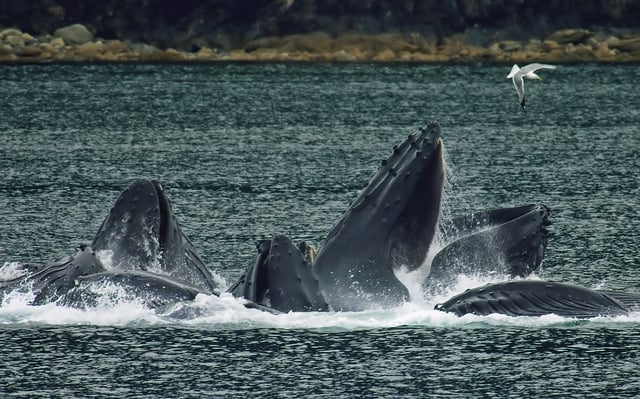
Bubble net feeding
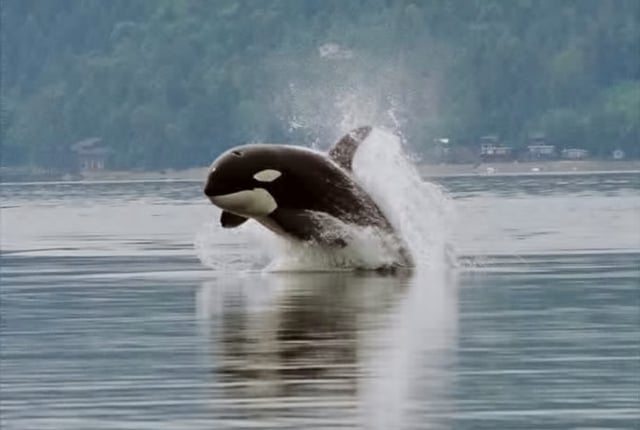
Killer whale porpoising
Cetacea are known to teach, learn, cooperate, scheme and grieve.[35]
Smaller cetaceans, such as dolphins and porpoises, engage in complex play behavior, including such things as producing stable underwater toroidal air-core vortex rings or "bubble rings". The two main methods of bubble ring production are rapid puffing of air into the water and allowing it to rise to the surface, forming a ring, or swimming repeatedly in a circle and then stopping to inject air into the helical vortex currents thus formed. They also appear to enjoy biting the vortex rings, so that they burst into many separate bubbles and then rise quickly to the surface. Whales produce bubble nets to aid in herding prey.[36]
Larger whales are also thought to engage in play. The southern right whale elevates its tail fluke above the water, remaining in the same position for a considerable time. This is known as "sailing". It appears to be a form of play and is most commonly seen off the coast of Argentina and South Africa.[37] Humpback whales also display this behaviour.
Self-awareness appears to be a sign of abstract thinking. Self-awareness, although not well-defined, is believed to be a precursor to more advanced processes such as metacognitive reasoning (thinking about thinking) that humans exploit. Cetaceans appear to possess self-awareness.[38] The most widely used test for self-awareness in animals is the mirror test, in which a temporary dye is placed on an animal's body and the animal is then presented with a mirror. Researchers then explore whether the animal shows signs of self-recognition.[39]
Critics claim that the results of these tests are susceptible to the Clever Hans effect. This test is much less definitive than when used for primates. Primates can touch the mark or the mirror, while cetaceans cannot, making their alleged self-recognition behavior less certain. Skeptics argue that behaviors said to identify self-awareness resemble existing social behaviors, so researchers could be misinterpreting self-awareness for social responses. Advocates counter that the behaviors are different from normal responses to another individual. Cetaceans show less definitive behavior of self-awareness, because they have no pointing ability.[39]
In 1995, Marten and Psarakos used video to test dolphin self-awareness.[40] They showed dolphins real-time footage of themselves, recorded footage and another dolphin. They concluded that their evidence suggested self-awareness rather than social behavior. While this particular study has not been replicated, dolphins later "passed" the mirror test.[39]
Life history
Reproduction and brooding
Most cetaceans sexually mature at seven to 10 years. An exception to this is the La Plata dolphin, which is sexually mature at two years, but lives only to about 20. The sperm whale reaches sexual maturity within about 20 years and a lifespan between 50 and 100 years.[33]
For most species, reproduction is seasonal. Ovulation coincides with male fertility. This cycle is usually coupled with seasonal movements that can be observed in many species. Most toothed whales have no fixed bonds. In many species, females choose several partners during a season. Baleen whales are largely monogamous within each reproductive period.
Gestation ranges from 9 to 16 months. Duration is not necessarily a function of size. Porpoises and blue whales gestate for about 11 months. As with all mammals other than marsupials and monotremes, the embryo is fed by the placenta, an organ that draws nutrients from the mother’s bloodstream. Mammals without placentas either lay minuscule eggs (monotremes) or bear minuscule offspring (marsupials).
Cetaceans usually bear one calf. In the case of twins, one usually dies, because the mother cannot produce sufficient milk for both. The fetus is positioned for a tail-first delivery, so that the risk of drowning during delivery is minimal. After birth, the mother carries the infant to the surface for its first breath. At birth they are about one-third of their adult length and tend to be independently active, comparable to terrestrial mammals.
Suckling
Like other placental mammals, cetaceans give birth to well-developed calves and nurse them with milk from their mammary glands. When suckling, the mother actively splashes milk into the mouth of the calf, using the muscles of her mammary glands, as the calf has no lips. This milk usually has a high fat content, ranging from 16 to 46%, causing the calf to increase rapidly in size and weight.[33]
In many small cetaceans, suckling lasts for about four months. In large species, it lasts for over a year and involves a strong bond between mother and offspring.
The mother is solely responsible for brooding. In some species, so-called "aunts" occasionally suckle the young.
This reproductive strategy provides a few offspring that have a high survival rate.
Lifespan
Among cetaceans, whales are distinguished by an unusual longevity compared to other higher mammals. Some species, such as the bowhead whale (Balaena mysticetus), can reach over 200 years. Based on the annual rings of the bony otic capsule, the age of the oldest known specimen is a male determined to be 211 years at the time of death.[41]
Death
Upon death, whale carcasses fall to the deep ocean and provide a substantial habitat for marine life. Evidence of whale falls in present-day and fossil records shows that deep-sea whale falls support a rich assemblage of creatures, with a global diversity of 407 species, comparable to other neritic biodiversity hotspots, such as cold seeps and hydrothermal vents.[42]
Deterioration of whale carcasses happens through three stages. Initially, organisms such as sharks and hagfish scavenge the soft tissues at a rapid rate over a period of months and as long as two years. This is followed by the colonization of bones and surrounding sediments (which contain organic matter) by enrichment opportunists, such as crustaceans and polychaetes, throughout a period of years. Finally, sulfophilic bacteria reduce the bones releasing hydrogen sulfide enabling the growth of chemoautotrophic organisms, which in turn, support organisms such as mussels, clams, limpets and sea snails. This stage may last for decades and supports a rich assemblage of species, averaging 185 per site.[42][43]
Disease
Brucellosis affects almost all mammals. It is distributed worldwide, while fishing and pollution have caused porpoise population density pockets, which risks further infection and disease spreading. Brucella ceti, most prevalent in dolphins, has been shown to cause chronic disease, increasing the chance of failed birth and miscarriages, male infertility, neurobrucellosis, cardiopathies, bone and skin lesions, strandings and death. Until 2008, no case had ever been reported in porpoises, but isolated populations have an increased risk and consequentially a high mortality rate.[44]
Evolution
Phylogenetics
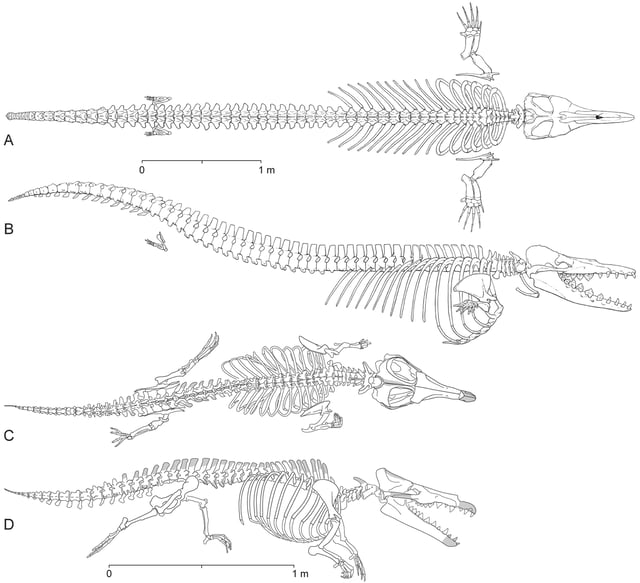
Two views of the skeletons of Dorudon atrox, extinct for 40 million years, and Maiacetus inuus, extinct for 47.5 million years, in the swimming position for comparison.[45]

Cetaceans display convergent evolution with fish and aquatic reptiles
Molecular biology and immunology show that cetaceans are phylogenetically closely related with the even-toed ungulates (Artiodactyla). Whales direct lineage began in the early Eocene, more than 50 million years ago, with early artiodactyls.[46] Fossil discoveries at the beginning of the 21st century confirmed this.
Most molecular biological evidence suggests that hippos are the closest living relatives. Common anatomical features include similarities in the morphology of the posterior molars, and the bony ring on the temporal bone (bulla) and the involucre, a skull feature that was previously associated only with cetaceans.[46] The fossil record, however, does not support this relationship, because the hippo lineage dates back only about 15 million years.[47][48][49] The most striking common feature is the talus, a bone in the upper ankle. Early cetaceans, archaeocetes, show double castors, which occur only in even-toed ungulates. Corresponding findings are from Tethys Sea deposits in northern India and Pakistan. The Tethys Sea was a shallow sea between the Asian continent and northward-bound Indian plate.
|
Mysticetes evolved baleen around 25 million years ago and lost their teeth.
Development
Ancestors
The direct ancestors of today's cetaceans are probably found within the Dorudontidae whose most famous member, Dorudon, lived at the same time as Basilosaurus. Both groups had already developed the typical anatomical features of today's whales, such as hearing. Life in the water for a formerly terrestrial creature required significant adjustments such as the fixed bulla, which replaces the mammalian eardrum, as well as sound-conducting elements for submerged directional hearing. Their wrists were stiffened and probably contributed to the typical build of flippers. The hind legs existed, however, but were significantly reduced in size and with a vestigial pelvis connection.[46]
Transition from land to sea
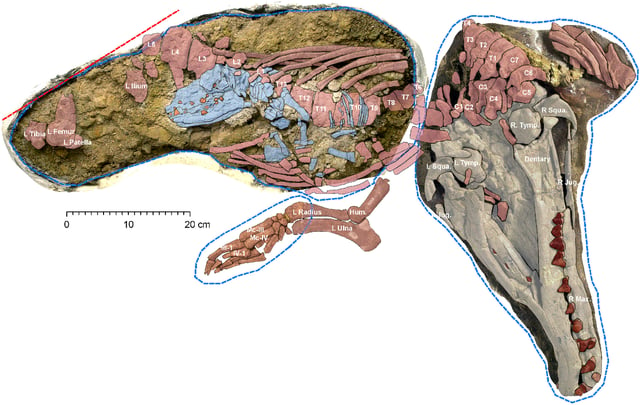
Fossil of a Maiacetus (red, beige skull) with fetus (blue, red teeth) shortly before the end of gestation [45]
The fossil record traces the gradual transition from terrestrial to aquatic life. The regression of the hind limbs allowed greater flexibility of the spine. This made it possible for whales to move around with the vertical tail hitting the water. The front legs transformed into flippers, costing them their mobility on land.
One of the oldest members of ancient cetaceans (Archaeoceti) is Pakicetus from the Middle Eocene. This is an animal the size of a wolf, whose skeleton is known only partially. It had functioning legs and lived near the shore. This suggests the animal could still move on land. The long snout had carnivorous dentition.[46]
The transition from land to sea dates to about 49 million years ago, with the Ambulocetus ("running whale"), discovered in Pakistan. It was up to 3 m (9.8 ft) long. The limbs of this archaeocete were leg-like, but it was already fully aquatic, indicating that a switch to a lifestyle independent from land happened extraordinarily quickly.[50] The snout was elongated with overhead nostrils and eyes. The tail was strong and supported movement through water. Ambulocetus probably lived in mangroves in brackish water and fed in the riparian zone as a predator of fish and other vertebrates.[51]
Dating from about 45 million years ago are species such as Indocetus, Kutchicetus, Rodhocetus and Andrewsiphius, all of which were adapted to life in water. The hind limbs of these species were regressed and their body shapes resemble modern whales. Protocetidae family member Rodhocetus is considered the first to be fully aquatic. The body was streamlined and delicate with extended hand and foot bones. The merged pelvic lumbar spine was present, making it possible to support the floating movement of the tail. It was likely a good swimmer, but could probably move only clumsily on land, much like a modern seal.[46]
Marine animals
Since the late Eocene, about 40 million years ago, cetaceans populated the subtropical oceans and no longer emerged on land. An example is the 18-m-long Basilosaurus, sometimes referred to as Zeuglodon. The transition from land to water was completed in about 10 million years. The Wadi Al-Hitan ("Whale Valley") in Egypt contains numerous skeletons of Basilosaurus, as well as other marine vertebrates.
Taxonomy
The two parvorders are baleen whales (Mysticeti) which owe their name to their baleen, and toothed whales (Odontoceti), which have teeth shaped like cones, spades, pegs or tusks, and can perceive their environment through biosonar.
The terms whale and dolphin are informal:
Mysticeti:
- Whales, with four families:Balaenidae(right and bowhead whales),Cetotheriidae(pygmy right whales),Balaenopteridae(rorquals),Eschrichtiidae(grey whales)
Odontoceti:
- Whales: with four families:Monodontidae(belugas and narwhals),Physeteridae(sperm whales),Kogiidae(dwarf and pygmy sperm whales), andZiphiidae(beaked whales)
- Dolphins, with four families:Delphinidae(oceanic dolphins),Platanistidae(South Asian river dolphins),Iniidae(new world river dolphins), andPontoporiidae(La Plata dolphins)
- Porpoises, with one family:Phocoenidae
The term 'great whales' covers those currently regulated by the International Whaling Commission:[52] the Odontoceti family Physeteridae (sperm whales); and the Mysticeti families Balaenidae (right and bowhead whales), Eschrichtiidae (grey whales), and some of the Balaenopteridae (minke, Bryde's, sei, blue and fin; not Eden's and Omura's whales).[53]
| Relationship of extinct and extant cetaceans[54]: |
†Recently extinct
INFRAORDER CETACEA Parvorder Mysticeti: baleen whales Superfamily Balaenoidea: right whales Family Balaenidae Genus Balaena Bowhead whale, Balaena mysticetus Genus Eubalaena North Atlantic right whale, Eubalaena glacialis North Pacific right whale, Eubalaena japonica Southern right whale, Eubalaena australis Family Cetotheriidae [55] Genus Caperea Pygmy right whale, Caperea marginata Superfamily Balaenopteroidea Family Balaenopteridae: rorquals Subfamily Balaenopterinae Genus Balaenoptera: slender rorquals Common minke whale, Balaenoptera acutorostrata Antarctic minke whale, Balaenoptera bonaerensis Sei whale, Balaenoptera borealis Bryde's whale, Balaenoptera brydei Eden's whale Balaenoptera edeni Omura's whale, Balaenoptera omurai Blue whale, Balaenoptera musculus Fin whale, Balaenoptera physalus Subfamily Megapterinae Genus Megaptera Humpback whale, Megaptera novaeangliae Family Eschrichtiidae: gray whales Genus Eschrichtius Gray whale, Eschrichtius robustus Parvorder Odontoceti: toothed whales Superfamily Delphinoidea Family Delphinidae: oceanic dolphins (though Orcaella & Sotalia can live in fresh water) Genus Cephalorhynchus: blunt-nosed dolphins Commerson's dolphin, Cephalorhynchus commersonii Chilean dolphin, Cephalorhynchus eutropia Heaviside's dolphin, Cephalorhynchus heavisidii Hector's dolphin, Cephalorhynchus hectori Genus Delphinus: common dolphins Long-beaked common dolphin, Delphinus capensis Short-beaked common dolphin, Delphinus delphis Arabian common dolphin, Delphinus tropicalis Genus Feresa Pygmy killer whale, Feresa attenuata Genus Globicephala: pilot whales Short-finned pilot whale, Globicephala macrorhyncus Long-finned pilot whale, Globicephala melas Genus Grampus Risso's dolphin, Grampus griseus Genus Lagenodelphis Fraser's dolphin, Lagenodelphis hosei Genus Lagenorhynchus: false bottlenose dolphins Atlantic white-sided dolphin, Lagenorhynchus acutus White-beaked dolphin, Lagenorhynchus albirostris Peale's dolphin, Lagenorhynchus australis Hourglass dolphin, Lagenorhynchus cruciger Pacific white-sided dolphin, Lagenorhynchus obliquidens Dusky dolphin, Lagenorhynchus obscurus Genus Lissodelphis: right whale dolphin Northern right whale dolphin, Lissodelphis borealis Southern right whale dolphin, Lissodelphis peronii Genus Orcaella: Irrawaddy dolphins Irrawaddy dolphin, Orcaella brevirostris Australian snubfin dolphin, Orcaella heinsohni Genus Orcinus Killer whale, Orcinus orca Genus Peponocephala Melon-headed whale, Peponocephala electra Genus Pseudorca False killer whale, Pseudorca crassidens Genus Sotalia: northern South American dolphins Tucuxi, Sotalia fluviatilis Guiana dolphin, Sotalia guianensis Genus Sousa: humpback dolphins Pacific humpback dolphin, Sousa chinensis Indian humpback dolphin, Sousa plumbea Atlantic humpback dolphin, Sousa teuszii Genus Stenella: spotted dolphins Pantropical spotted dolphin, Stenella attenuata Clymene dolphin, Stenella clymene Striped dolphin, Stenella coeruleoalba Atlantic spotted dolphin, Stenella frontalis Spinner dolphin, Stenella longirostris Genus Steno Rough-toothed dolphin, Steno bredanensis Genus Tursiops: true bottlenose dolphins Indian Ocean bottlenose dolphin, Tursiops aduncus Burrunan dolphin, Tursiops australis Common bottlenose dolphin, Tursiops truncatus Family Monodontidae: Arctic whales Genus Delphinapterus Beluga, Delphinapterus leucas Genus Monodon Narwhal, Monodon monoceros Family Phocoenidae: porpoises Genus Neophocaena Finless porpoise, Neophocaena phocaenoides Genus Phocoena Spectacled porpoise, Phocoena dioptrica Harbour porpoise, Phocoena phocaena Vaquita, Phocoena sinus Burmeister's porpoise, Phocoena spinipinnis Genus Phocoenoides Dall's porpoise, Phocoenoides dalli Superfamily Physeteroidea: sperm whales Family Physeteridae Genus Physeter Sperm whale, Physeter catodon (syn. P. macrocephalus) Family Kogiidae: lesser sperm whales Genus Kogia Pygmy sperm whale, Kogia breviceps Dwarf sperm whale, Kogia sima Superfamily Platanistoidea: Indian river dolphins Family Platanistidae Genus Platanista South Asian river dolphin, Platanista gangetica Superfamily Inioidea: South American river dolphins Family Iniidae Genus Inia Amazon river dolphin, Inia geoffrensis Bolivian river dolphin, Inia boliviensis Araguaian river dolphin, Inia araguaiaensis Family Pontoporiidae Genus Pontoporia La Plata dolphin, Pontoporia blainvillei Superfamily Ziphioidea: beaked whales Family Ziphiidae Genus Berardius: giant beaked whales Arnoux's beaked whale, Berardius arnuxii Baird's beaked whale (North Pacific bottlenose whale), Berardius bairdii Berardius minimus Subfamily Hyperoodontidae Genus Hyperoodon: bottlenose whales Northern bottlenose whale, Hyperoodon ampullatus Southern bottlenose whale, Hyperoodon planifrons Genus Indopacetus Indo-Pacific beaked whale (Longman's beaked whale), Indopacetus pacificus Genus Mesoplodon, Mesoplodont whale Sowerby's beaked whale, Mesoplodon bidens Andrews' beaked whale, Mesoplodon bowdoini Hubbs' beaked whale, Mesoplodon carlhubbsi Blainville's beaked whale, Mesoplodon densirostris Gervais' beaked whale, Mesoplodon europaeus Ginkgo-toothed beaked whale, Mesoplodon ginkgodens Gray's beaked whale, Mesoplodon grayi Hector's beaked whale, Mesoplodon hectori Strap-toothed whale, Mesoplodon layardii True's beaked whale, Mesoplodon mirus Perrin's beaked whale, Mesoplodon perrini Pygmy beaked whale, Mesoplodon peruvianus Stejneger's beaked whale, Mesoplodon stejnegeri Spade-toothed whale, Mesoplodon traversii Deraniyagala's beaked whale, Mesoplodon hotaula Genus Tasmacetus Shepherd's beaked whale, Tasmacetus shepherdi Genus Ziphius Cuvier's beaked whale, Ziphius cavirostris
Status
Threats
The primary threats to cetaceans come from people, both directly from whaling or drive hunting and indirect threats from fishing and pollution.[56]
Whaling
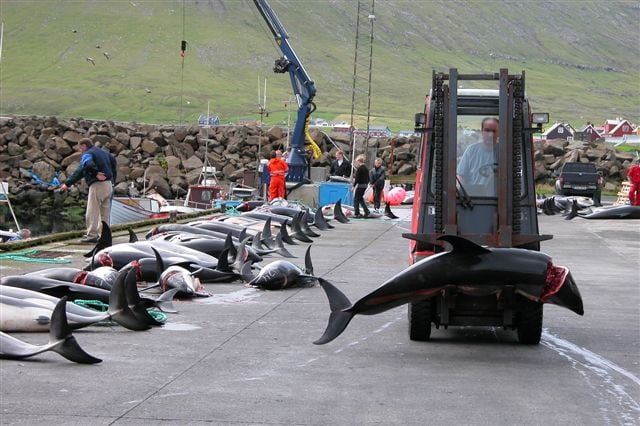
An Atlantic white-sided dlphin caught in a drive hunt in Hvalba on the Faroe Islands being taken away with a forklift.
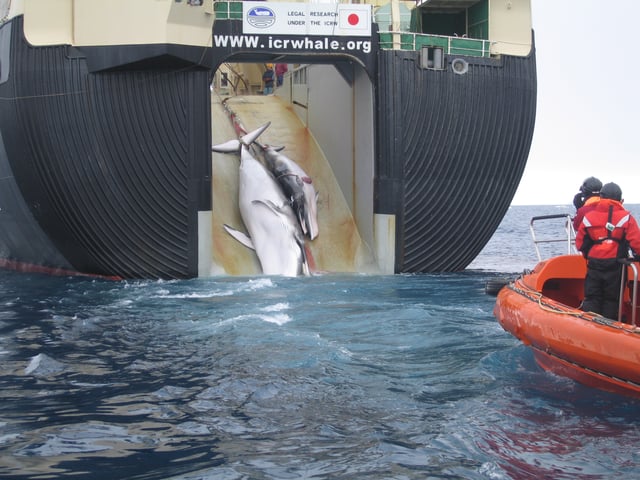
Japanese research ship whaling mother and calf minke whales.
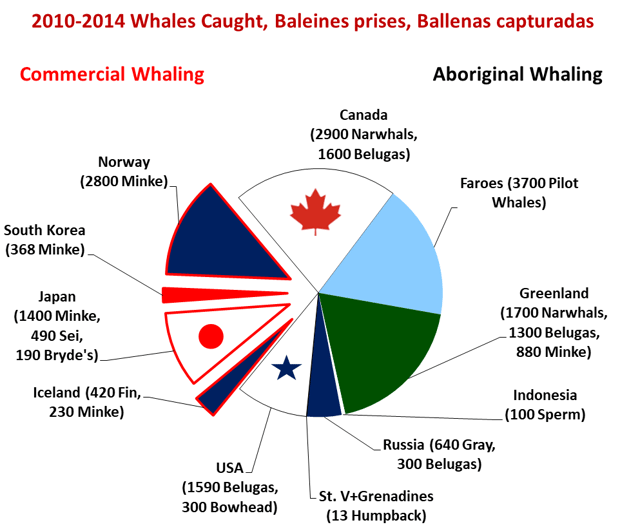
Whales caught 2010-2014, by country
Whaling is the practice of hunting whales, mainly baleen and sperm whales. This activity has gone on since the Stone Age.
In the Middle Ages, reasons for whaling included their meat, oil usable as fuel and the jawbone, which was used in house construction. At the end of the Middle Ages, early whaling fleets aimed at baleen whales, such as bowheads. In the 16th and 17th centuries, the Dutch fleet had about 300 whaling ships with 18,000 crewmen.
In the 18th and 19th centuries, baleen whales especially were hunted for their baleen, which was used as a replacement for wood, or in products requiring strength and flexibility such as corsets and crinoline skirts. In addition, the spermaceti found in the sperm whale was used as a machine lubricant and the ambergris as a material for pharmaceutical and perfume industries. In the second half of the 19th century, the explosive harpoon was invented, leading to a massive increase in the catch size.
Large ships were used as "mother" ships for the whale handlers. In the first half of the 20th century, whales were of great importance as a supplier of raw materials. Whales were intensively hunted during this time; in the 1930s, 30,000 whales were killed. This increased to over 40,000 animals per year up to the 1960s, when stocks of large baleen whales collapsed.
Most hunted whales are now threatened, with some great whale populations exploited to the brink of extinction. Atlantic and Korean gray whale populations were completely eradicated and the North Atlantic right whale population fell to some 300-600. The blue whale population is estimated to be around 14,000.
The first efforts to protect whales came in 1931. Some particularly endangered species, such as the humpback whale (which then numbered about 100 animals), were placed under international protection and the first protected areas were established. In 1946, the International Whaling Commission (IWC) was established, to monitor and secure whale stocks. Whaling of 14 large species for commercial purposes was prohibited worldwide by this organization from 1985 to 2005, though some countries do not honor the prohibition.
The stocks of species such as humpback and blue whales have recovered, though they are still threatened. The United States Congress passed the Marine Mammal Protection Act of 1972 sustain the marine mammal population. It prohibits the taking of marine mammals except for several hundred per year taken in Alaska. Japanese whaling ships are allowed to hunt whales of different species for ostensibly scientific purposes.
Aboriginal whaling is still permitted. About 1,200 pilot whales were taken in the Faroe Islands in 2017.,[57] and about 900 narwhals and 800 belugas per year are taken in Alaska, Canada, Greenland, and Siberia. About 150 minke are taken in Greenland per year, 120 gray whales in Siberia and 50 bowheads in Alaska, as aboriginal whaling, besides the 600 minke taken commercially by Norway, 300 minke and 100 sei taken by Japan and up to 100 fin whales taken by Iceland.[58] Iceland and Norway do not recognize the ban and operate commercial whaling. Norway and Japan are committed to ending the ban.
Dolphins and other smaller cetaceans are sometimes hunted in an activity known as dolphin drive hunting. This is accomplished by driving a pod together with boats, usually into a bay or onto a beach. Their escape is prevented by closing off the route to the ocean with other boats or nets. Dolphins are hunted this way in several places around the world, including the Solomon Islands, the Faroe Islands, Peru and Japan (the most well-known practitioner). Dolphins are mostly hunted for their meat, though some end up in dolphinaria. Despite the controversy thousands of dolphins are caught in drive hunts each year.
Fishing

Dominoes made of baleen
Dolphin pods often reside near large tuna shoals. This is known to fishermen, who look for dolphins to catch tuna. Dolphins are much easier to spot from a distance than tuna, since they regularly breathe. The fishermen pull their nets hundreds of meters wide in a circle around the dolphin groups, in the expectation that they will net a tuna shoal. When the nets are pulled together, the dolphins become entangled under water and drown. Line fisheries in larger rivers are threats to river dolphins.
A greater threat than by-catch for small cetaceans is targeted hunting. In Southeast Asia, they are sold as fish-replacement to locals, since the region's edible fish promise higher revenues from exports. In the Mediterranean, small cetaceans are targeted to ease pressure on edible fish.[56]
Strandings
A stranding is when a cetacean leaves the water to lie on a beach. In some cases, groups of whales strand together. The best known are mass strandings of pilot whales and sperm whales. Stranded cetaceans usually die, because their as much as 90 metric tons (99 short tons) body weight compresses their lungs or breaks their ribs. Smaller whales can die of heatstroke because of their thermal insulation.
The causes are not clear. Possible reasons for mass beachings are:[56]
toxic contaminants
debilitating parasites (in the respiratory tract, brain or middle ear)
infections (bacterial or viral)
flight from predators (including humans)
social bonds within a group, so that the pod follows a stranded animal
disturbance of their magnetic senses by natural anomalies in the Earth's magnetic field
injuries
noise pollution by shipping traffic, seismic surveys and military sonar experiments
Since 2000, whale strandings frequently occurred following military sonar testing. In December 2001, the US Navy admitted partial responsibility for the beaching and the deaths of several marine mammals in March 2000. The coauthor of the interim report stated that animals killed by active sonar of some Navy ships were injured. Generally, underwater noise, which is still on the increase, is increasingly tied to strandings; because it impairs communication and sense of direction.[59]
Climate change influences the major wind systems and ocean currents, which also lead to cetacean strandings. Researchers studying strandings on the Tasmanian coast from 1920–2002 found that greater strandings occurred at certain time intervals. Years with increased strandings were associated with severe storms, which initiated cold water flows close to the coast. In nutrient-rich, cold water, cetaceans expect large prey animals, so they follow the cold water currents into shallower waters, where the risk is higher for strandings. Whales and dolphins who live in pods may accompany sick or debilitated pod members into shallow water, stranding them at low tide. Once stranded, large whales are crushed by their own body weight, if they cannot quickly return to the water. In addition, body temperature regulation is compromised.
Environmental hazards
Worldwide, use of active sonar has been linked to about 50 marine mammal strandings between 1996 and 2006. In all of these occurrences, there were other contributing factors, such as unusual (steep and complex) underwater geography, limited egress routes, and a specific species of marine mammal — beaked whales — that are suspected to be more sensitive to sound than other marine mammals. —Rear Admiral Lawrence Rice
Heavy metals, residues of many plant and insect venoms and plastic waste flotsam are not biodegradable. Sometimes, cetaceans consume these hazardous materials, mistaking them for food items. As a result, the animals are more susceptible to disease and have fewer offspring.[56]
Damage to the ozone layer reduces plankton reproduction because of its resulting radiation. This shrinks the food supply for many marine animals, but the filter-feeding baleen whales are most impacted. Even the Nekton is, in addition to intensive exploitation, damaged by the radiation.[56]
Food supplies are also reduced long-term by ocean acidification due to increased absorption of increased atmospheric carbon dioxide. The CO2 reacts with water to form carbonic acid, which reduces the construction of the calcium carbonate skeletons of food supplies for zooplankton that baleen whales depend on.[56]
The military and resource extraction industries operate strong sonar and blasting operations. Marine seismic surveys use loud, low-frequency sound that show what is lying underneath the Earth's surface.[60] Vessel traffic also increases noise in the oceans. Such noise can disrupt cetacean behavior such as their use of biosonar for orientation and communication. Severe instances can panic them, driving them to the surface. This leads to bubbles in blood gases and can cause decompression sickness.[61] Naval exercises with sonar regularly results in fallen cetaceans that wash up with fatal decompression. Sounds can be disruptive at distances of more than 100 kilometres (62 mi). Damage varies across frequency and species.
Relationship to humans
Research history
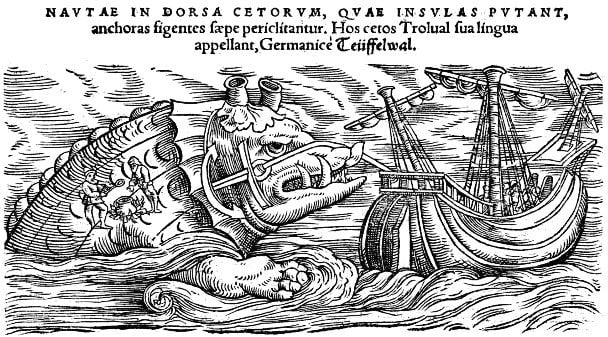
A whale as depicted by Conrad Gesner, 1587, in Historiae animalium
In Aristotle's time, the 4th century BCE, whales were regarded as fish due to their superficial similarity. Aristotle, however, observed many physiological and anatomical similarities with the terrestrial vertebrates, such as blood (circulation), lungs, uterus and fin anatomy.[62] His detailed descriptions were assimilated by the Romans, but mixed with a more accurate knowledge of the dolphins, as mentioned by Pliny the Elder in his Natural history. In the art of this and subsequent periods, dolphins are portrayed with a high-arched head (typical of porpoises) and a long snout. The harbour porpoise was one of the most accessible species for early cetologists; because it could be seen close to land, inhabiting shallow coastal areas of Europe. Much of the findings that apply to all cetaceans were first discovered in porpoises.[63] One of the first anatomical descriptions of the airways of a harbor porpoise dates from 1671 by John Ray. It nevertheless referred to the porpoise as a fish.[64][65]
The tube in the head, through which this kind fish takes its breath and spitting water, located in front of the brain and ends outwardly in a simple hole, but inside it is divided by a downward bony septum, as if it were two nostrils; but underneath it opens up again in the mouth in a void.— John Ray, 1671, the earliest description of cetacean airways
In the 10th edition of Systema Naturae (1758), Swedish biologist and taxonomist Carl Linnaeus asserted that cetaceans were mammals and not fish. His groundbreaking binomial system formed the basis of modern whale classification.
Culture
Cetaceans play a role in human culture.
Prehistoric
Antiquity
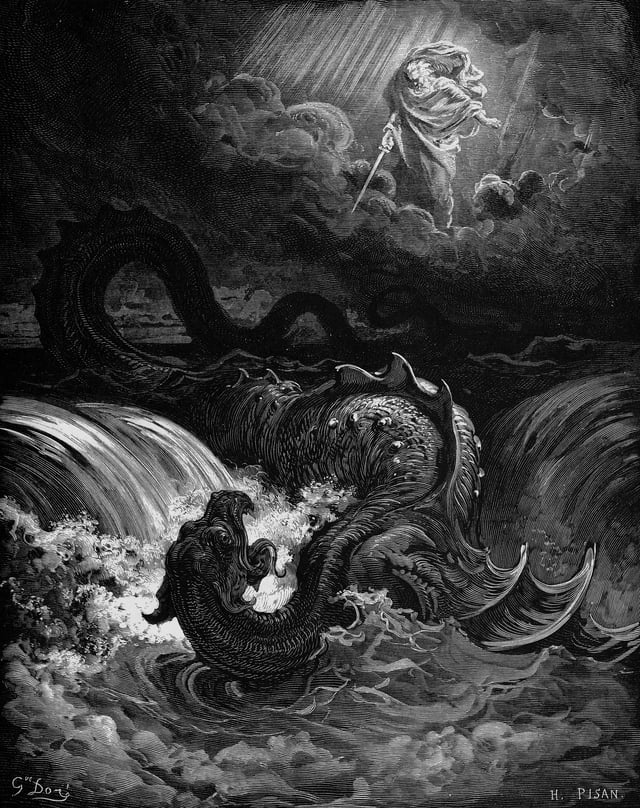
"Destruction of Leviathan" engraving by Gustave Doré, 1865
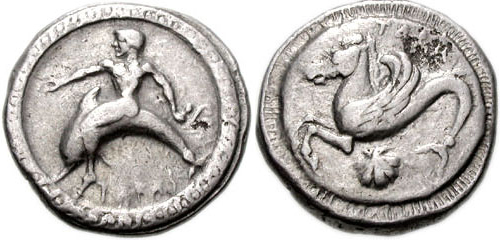
Silver coin with Tarus riding a dolphin
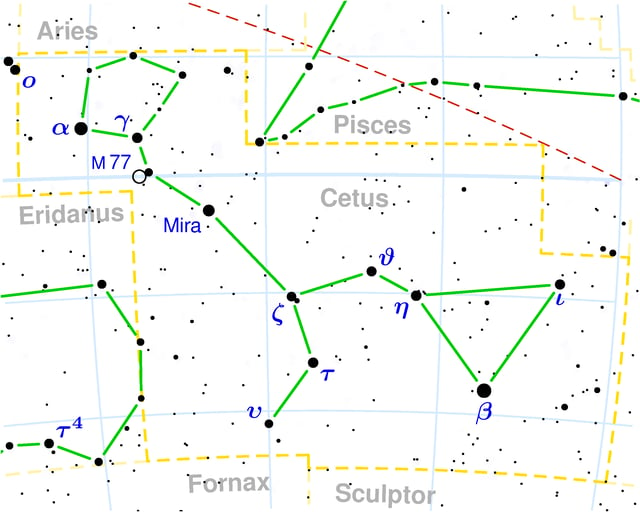
Constellation Cetus
The whale was first mentioned in ancient Greece by Homer. There, it is called Ketos, a term that initially included all large marine animals. From this was derived the Roman word for whale, Cetus. Other names were phálaina (Aristotle, Latin form of ballaena) for the female and, with an ironic characteristic style, musculus (Mouse) for the male. North Sea whales were called Physeter, which was meant for the sperm whale Physter macrocephalus. Whales are described in particular by Aristotle, Pliny and Ambrose. All mention both live birth and suckling. Pliny describes the problems associated with the lungs with spray tubes and Ambrose claimed that large whales would take their young into their mouth to protect them.
In the Bible especially, the leviathan plays a role as a sea monster. The essence, which features a giant crocodile or a dragon and a whale, was created according to the Bible by God[68] and should again be destroyed by him.[69][70] In the Book of Job, the leviathan is described in more detail.[71][72]
In Jonah there is a more recognizable description of a whale alongside the prophet Jonah, who, on his flight from the city of Nineveh is swallowed by a whale.
Dolphins are mentioned far more often than whales. Aristotle discusses the sacred animals of the Greeks in his Historia Animalium and gives details of their role as aquatic animals. The Greeks admired the dolphin as a "king of the aquatic animals" and referred to them erroneously as fish. Its intelligence was apparent both in its ability to escape from fishnets and in its collaboration with fishermen.
Dolphins appear in Greek mythology. Because of their intelligence, they rescued multiple people from drowning. They were said to love music – probably not least because of their own song – they saved, in the legends, famous musicians such as Arion of Lesbos from Methymna or Kairanos from Miletus. Because of their mental faculties, dolphins were considered for the god Dionysus.
Dolphins belong to the domain of Poseidon and led him to his wife Amphitrite. Dolphins are associated with other gods, such as Apollo, Dionysus and Aphrodite. The Greeks paid tribute to both whales and dolphins with their own constellation. The constellation of the Whale (Ketos, lat. Cetus) is located south of the Dolphin (Delphi, lat. Delphinus) north of the zodiac.
Ancient art often included dolphin representations, including the Cretan Minoans. Later they appeared on reliefs, gems, lamps, coins, mosaics and gravestones. A particularly popular representation is that of Arion or the Taras (mythology) riding on a dolphin. In early Christian art, the dolphin is a popular motif, at times used as a symbol of Christ.
Middle Ages to the 19th century
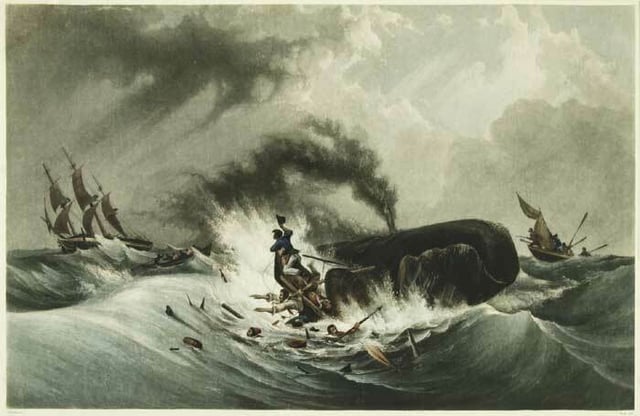
Depiction of baleen whaling, 1840
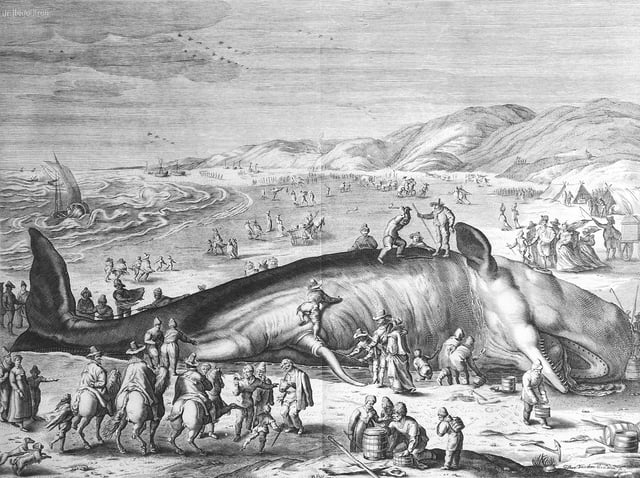
Stranded sperm whale engraving, 1598
St. Brendan described in his travel story Navigatio Sancti Brendani an encounter with a whale, between the years 565–573. He described how he and his companions entered a treeless island, which turned out to be a giant whale, which he called Jasconicus. He met this whale seven years later and rested on his back.
Most descriptions of large whales from this time until the whaling era, beginning in the 17th century, were of beached whales, which resembled no other animal. This was particularly true for the sperm whale, the most frequently stranded in larger groups. Raymond Gilmore documented seventeen sperm whales in the estuary of the Elbe from 1723 to 1959 and thirty-one animals on the coast of Great Britain in 1784. In 1827, a blue whale beached itself off the coast of Ostend. Whales were used as attractions in museums and traveling exhibitions.
Whalers from the 17th to 19th centuries depicted whales in drawings and recounted tales of their occupation. Although they knew that whales were harmless giants, they described battles with harpooned animals. These included descriptions of sea monsters, including huge whales, sharks, sea snakes, giant squid and octopuses.
Among the first whalers who described their experiences on whaling trips was Captain William Scoresby from Great Britain, who published the book Northern Whale Fishery, describing the hunt for northern baleen whales. This was followed by Thomas Beale, a British surgeon, in his book Some observations on the natural history of the sperm whale in 1835; and Frederick Debell Bennett's The tale of a whale hunt in 1840. Whales were described in narrative literature and paintings, most famously in the novels Moby Dick by Herman Melville and 20,000 Leagues Under the Sea by Jules Verne.
Baleen was used to make vessel components such as the bottom of a bucket in the Scottish National Museum. The Norsemen crafted ornamented plates from baleen, sometimes interpreted as ironing boards.
In the Canadian Arctic (east coast) in Punuk and Thule culture (1000–1600 C.E.),[73] I baleen was used to construct houses in place of wood as roof support for winter houses, with half of the building buried under the ground. The actual roof was probably made of animal skins that were covered with soil and moss.[74]
Modern culture
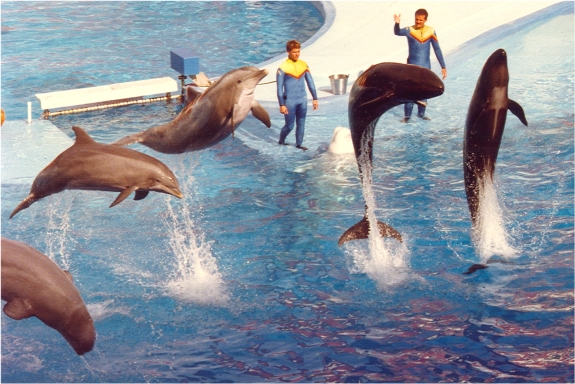
Sea World show featuring bottlenose dolphins and false killer whales
In the 20th century perceptions of cetaceans changed. They transformed from monsters into creatures of wonder, as science revealed them to be intelligent and peaceful animals. Hunting was replaced by whale and dolphin tourism. This change is reflected in films and novels. For example, the protagonist of the series Flipper was a bottle-nose dolphin. The TV series SeaQuest DSV (1993–1996), the movies Free Willy, Star Trek IV: The Voyage Home and the book series The Hitchhiker's Guide to the Galaxy by Douglas Adams are examples.[75]
The study of whale song also produced a popular album, Songs of the Humpback Whale.
Captivity
Whales and dolphins have been kept in captivity for use in education, research and entertainment since the 19th century.
Belugas
Beluga whales were the first whales to be kept in captivity. Other species were too rare, too shy or too big. The first was shown at Barnum's Museum in New York City in 1861.[76] For most of the 20th century, Canada was the predominant source.[77] They were taken from the St. Lawrence River estuary until the late 1960s, after which they were predominantly taken from the Churchill River estuary until capture was banned in 1992.[77] Russia then became the largest provider.[77] Belugas are caught in the Amur Darya delta and their eastern coast and are transported domestically to aquaria or dolphinaria in Moscow, St. Petersburg and Sochi, or exported to countries such as Canada.[77] They have not been domesticated.[78]
As of 2006, 30 belugas lived in Canada and 28 in the United States. 42 deaths in captivity had been reported.[77] A single specimen can reportedly fetch up to US$100,000 (UK£64,160). The beluga's popularity is due to its unique color and its facial expressions. The latter is possible because while most cetacean "smiles" are fixed, the extra movement afforded by the beluga's unfused cervical vertebrae allows a greater range of apparent expression.[79]
Killer whales
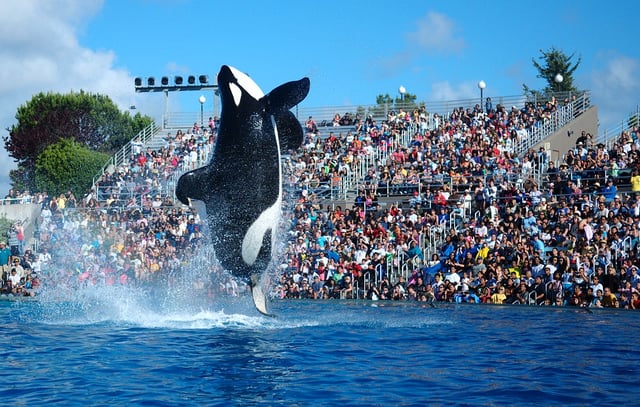
Shamu the killer whale, 2009
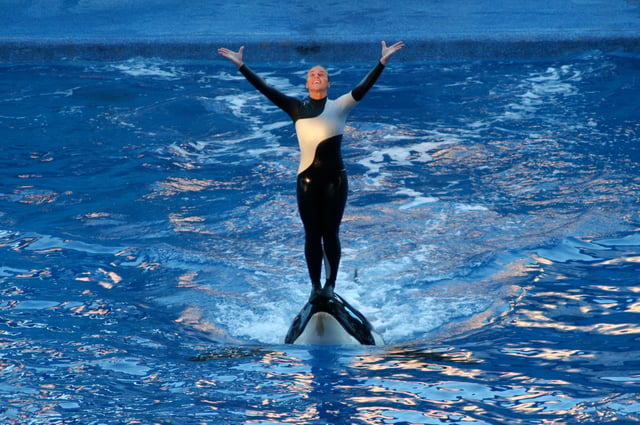
Dawn Brancheau doing a show four years before the incident
The killer whale's intelligence, trainability, striking appearance, playfulness in captivity and sheer size have made it a popular exhibit at aquaria and aquatic theme parks. From 1976 to 1997, fifty-five whales were taken from the wild in Iceland, nineteen from Japan and three from Argentina. These figures exclude animals that died during capture. Live captures fell dramatically in the 1990s and by 1999, about 40% of the forty-eight animals on display in the world were captive-born.[80]
Organizations such as World Animal Protection and the Whale and Dolphin Conservation campaign against the practice of keeping them in captivity.
In captivity, they often develop pathologies, such as the dorsal fin collapse seen in 60–90% of captive males. Captives have reduced life expectancy, on average only living into their 20s, although some live longer, including several over 30 years old and two, Corky II and Lolita, in their mid-40s. In the wild, females who survive infancy live 46 years on average and up to 70–80 years. Wild males who survive infancy live 31 years on average and can reach 50–60 years.[81]
Captivity usually bears little resemblance to wild habitat and captive whales' social groups are foreign to those found in the wild. Critics claim captive life is stressful due to these factors and the requirement to perform circus tricks that are not part of wild killer whale behavior. Wild killer whales may travel up to 160 kilometres (100 mi) in a day and critics say the animals are too big and intelligent to be suitable for captivity.[82] Captives occasionally act aggressively towards themselves, their tankmates, or humans, which critics say is a result of stress.[83] Killer whales are well known for their performances in shows, but the number of orcas kept in captivity is small, especially when compared to the number of bottlenose dolphins, with only forty-four captive orcas being held in aquaria as of 2012.[84]
Each country has its own tank requirements; in the US, the minimum enclosure size is set by the Code of Federal Regulations, 9 CFR E § 3.104, under the Specifications for the Humane Handling, Care, Treatment and Transportation of Marine Mammals.[85]
Aggression among captive killer whales is common. They attack each other and their trainers as well. In 2013, SeaWorld's treatment of killer whales in captivity was the basis of the movie Blackfish, which documents the history of Tilikum, a killer whale at SeaWorld Orlando, who had been involved in the deaths of three people.[86] The film led to proposals by some lawmakers to ban captivity of cetaceans, and lead SeaWorld to announce in 2016 that it would phase out its killer whale program after various unsuccessful attempts to restore its revenues, reputation, and stock price.[87]
Others

SeaWorld pilot whale with trainers
Dolphins and porpoises are kept in captivity. Bottlenose dolphins are the most common, as they are relatively easy to train, have a long lifespan in captivity and have a friendly appearance. Bottlenose dolphins live in captivity across the world, though exact numbers are hard to determine. Other species kept in captivity are spotted dolphins, false killer whales and common dolphins, Commerson's dolphins, as well as rough-toothed dolphins, but all in much lower numbers. There are also fewer than ten pilot whales, Amazon river dolphins, Risso's dolphins, spinner dolphins, or tucuxi in captivity. Two unusual and rare hybrid dolphins, known as wolphins, are kept at Sea Life Park in Hawaii, which is a cross between a bottlenose dolphin and a false killer whale. Also, two common/bottlenose hybrids reside in captivity at Discovery Cove and SeaWorld San Diego.
In repeated attempts in the 1960s and 1970s, narwhals kept in captivity died within months. A breeding pair of pygmy right whales were retained in a netted area. They were eventually released in South Africa. In 1971, SeaWorld captured a California gray whale calf in Mexico at Scammon's Lagoon. The calf, later named Gigi, was separated from her mother using a form of lasso attached to her flukes. Gigi was displayed at SeaWorld San Diego for a year. She was then released with a radio beacon affixed to her back; however, contact was lost after three weeks. Gigi was the first captive baleen whale. JJ, another gray whale calf, was kept at SeaWorld San Diego. JJ was an orphaned calf that beached itself in April 1997 and was transported two miles to SeaWorld. The 680 kilograms (1,500 lb) calf was a popular attraction and behaved normally, despite separation from his mother. A year later, the then 8,164.7 kilograms (18,000 lb) whale though smaller than average, was too big to keep in captivity, and was released on April 1, 1998. A captive Amazon river dolphin housed at Acuario de Valencia is the only trained river dolphin in captivity.[88][89]
Here is a list of all the cetaceans that have been taken into captivity for either conservation or human entertainment purposes currently or in the past, temporarily or permanently.
Orca
Vaquita
False killer whale
Pygmy killer whale
Long-finned pilot whale
Short-finned pilot whale
Bottlenose dolphin
Beluga whale
Pacific white-sided dolphin
Risso's dolphin
Atlantic white-sided dolphin
Narwhal
Spotted dolphin
Spinner dolphin
Common dolphin
Harbour porpoise
Finless porpoise
Commerson's dolphin
Rough-toothed dolphin
Boto
Tucuxi
Wholphin
Gray whale
Pygmy sperm whale
Irrawaddy dolphin
Indo-Pacific hump-backed dolphin
Baiji
Melon-headed whale
South Asian river dolphin
Minke whale